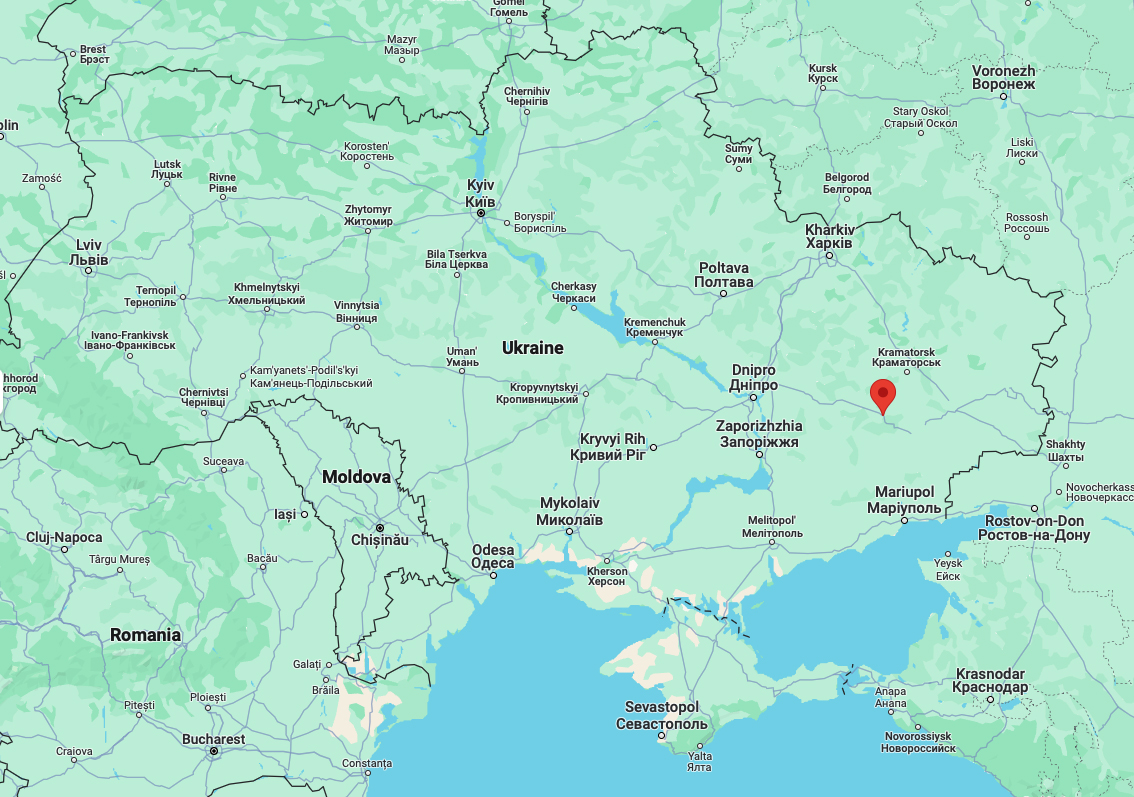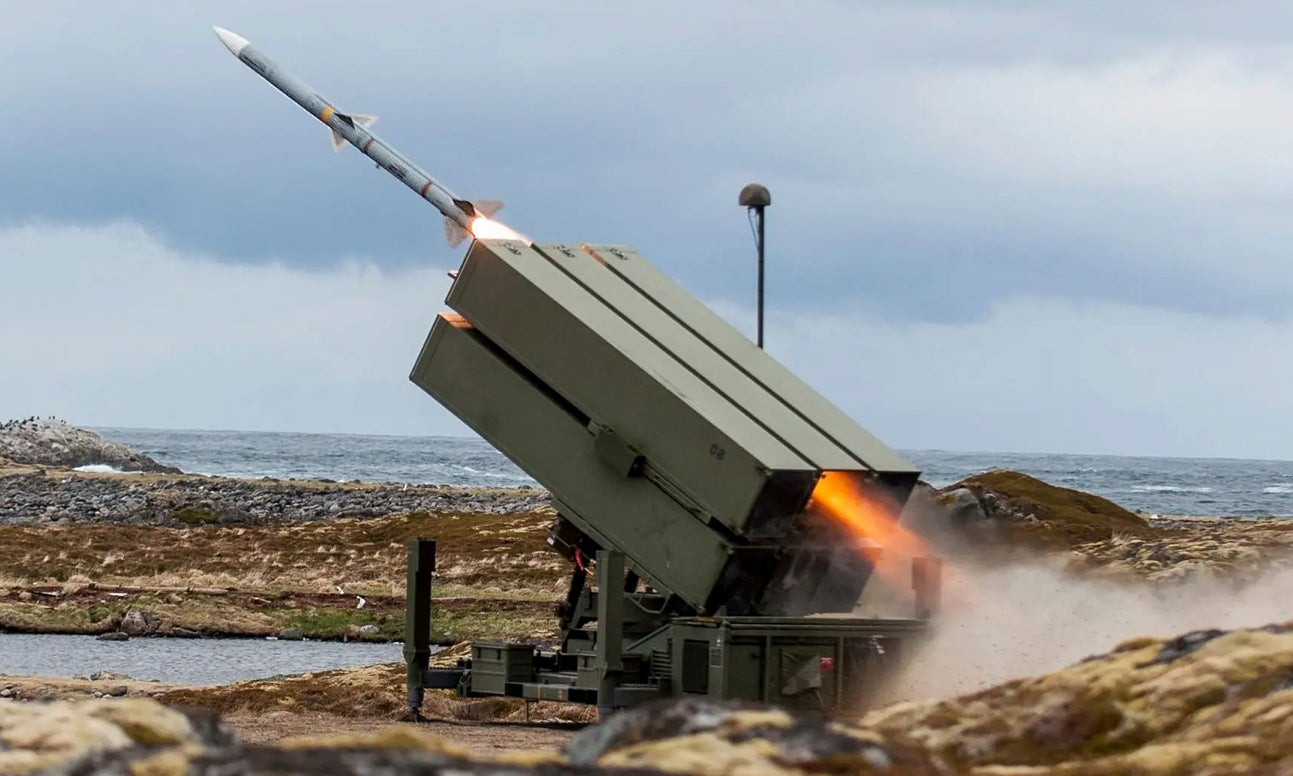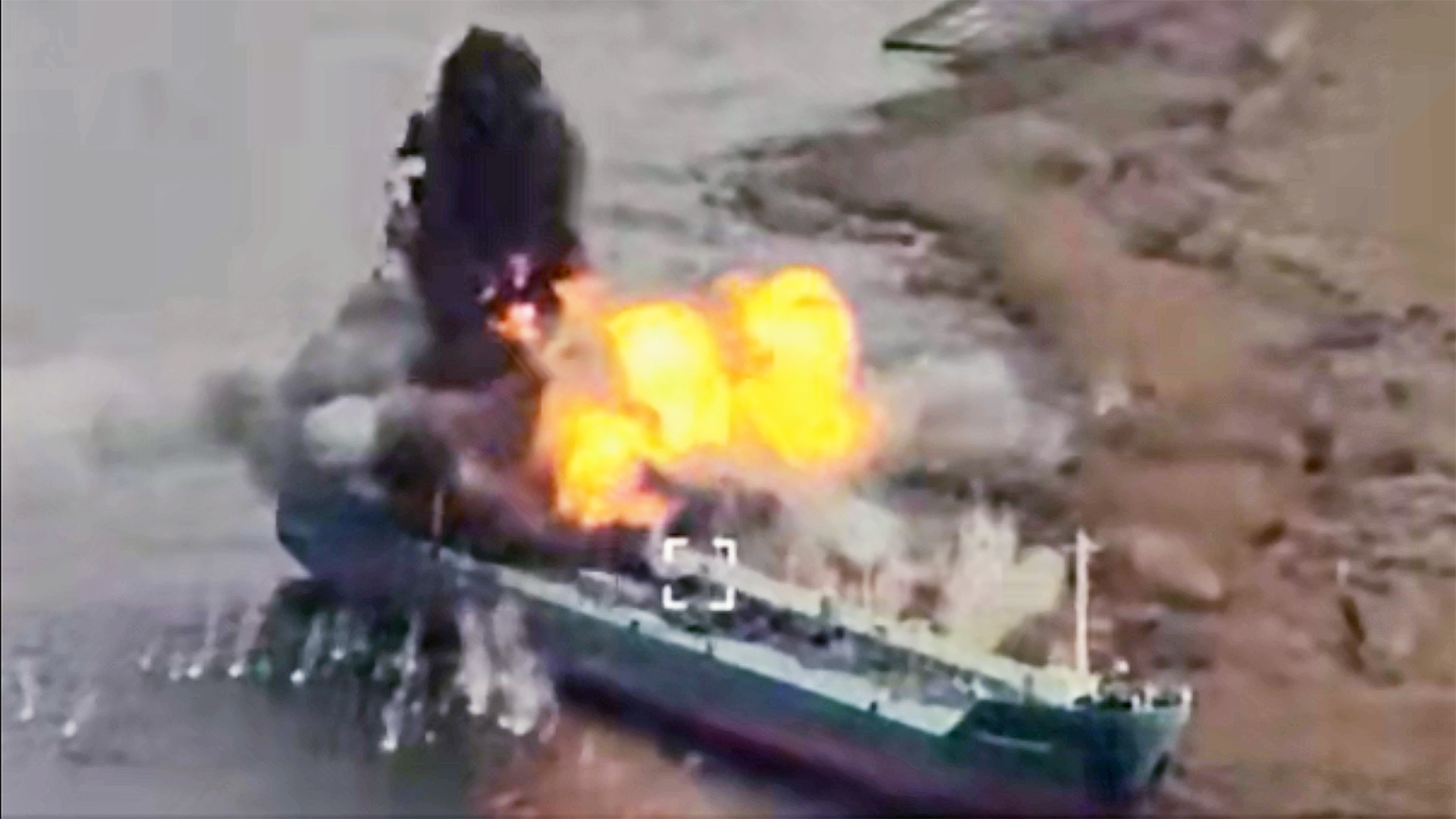Ukraine’s armed forces have shared a video showing what they say is a strike on a ship that was being used as an improvised base for Russian operations. The grounded ship is located on the south side of the Dnipro River, near the city of Kherson.
What weapon was used in the strike isn’t clear, but it stuck with significant force. A Storm Shadow or SCALP-EG may have been the culprit considering where the ship was hit, the damage that was caused, and especially if the vessel was fully grounded and not moving significantly with the tides. A JDAM-ER precision-guided bomb is another possibility, although a less likely one due to a number of factors, including the effects we are seeing in the video.
A Ukrainian Neptune missile, anti-ship and land-attack versions of which are now said to be in service, could be another possibility. However, the Ukrainian Air Force said it carried out the strike while the country’s Navy is the only known operator of Neptunes.
Regardless, huge pieces of the ship can be seen flying into the water as a result of the strike.
The once Russian-flagged tanker, which is named Mechanic Pogodin, has an interesting backstory. As far as we can tell, it was seized by Ukraine years ago and had remained docked in Kherson before slipping its moorings and ending on the other side of the River.
Some say that the destruction of the Nova Kakhovka Dam in June of 2023 resulted in it breaking free and floating into its current position. Satellite imagery The War Zone has examined supports that claim. The Russians supposedly commandeered the abandoned ship for use as a surveillance post and forward base. From its location just downriver and across from Ukraine-held Kherson, it could have provided an opportune position for collecting intelligence, especially on amphibious operations on the contested waterway, stage, and more.
Whatever the case, the ship has now met a very violent end.
Before diving into more developments from the conflict in Ukraine, The War Zone readers can review our previous coverage here.
The Latest
Claims are swirling around a Russian strike on what appears to be one, and possibly two, Patriot surface-to-air missile launchers, which are precious assets only available to Ukraine in limited numbers.
Russia originally released a video showing a drone spotting the vehicles and a subsequent strike by what it says was an Iskander-M short-range ballistic missile. The Iskander-Ms are valued weapons that now exist in reduced quantity within Russia’s arsenal. They are also the most capable weapon Russia has for executing time-sensitive precision strikes inside Ukrainian-controlled territory. As such, as long as the Russians had enough time to get the missile targeted and fired, and the target was stationary, it makes sense that it was used to strike a high-value asset like a top-end air defense system. The explosion is also indicative of the large conventional warhead found on the Iskander-M, along with secondaries from the surface-to-air missiles.
Russia also says it hit components from an S-300 air defense system, but many are refuting that claim based on the visual evidence, saying it was indeed a Patriot launcher, or launchers, that were destroyed. This does look increasingly likely at this point.
We have to highlight that this is not the same as destroying an entire Patriot battery. We have visual evidence that indicates specifically that the launchers and associated equipment were totally destroyed in this incident. While limited damage to a Patriot’s components has been disclosed before, the complete loss of any of them would be a first.
If the location information is indeed correct, with the incident occurring near the town of Pokrovsk, this would be evidence that Ukraine is indeed deploying Patriots close to the front lines, and in this case, in the far east of the country. This is something we have posited for many months and it would help explain Ukraine’s claims of significant kills of Russian tactical aircraft in recent weeks.

Such an operation would not be without major risks. The close proximity to the front lines and a lack of other layers of protection from Ukraine’s most advanced air defense systems, such as what is found around the capital Kyiv, would mean the forward-deployed Patriots would be more vulnerable to attack. The Patriot system, and Ukraine’s other more capable air defense assets, were always going to be at the top of Russia’s targeting list.
The delivery of much-needed modern air defense systems that were already promised to Ukraine is also hitting a snag. The Edmonton Journal reports that the delivery of a National Advanced Surface to Air Missile System (NASAMS) battery bought in part by Canada for Ukraine is being held up due to gridlock on aid to Ukraine in the U.S. Congress.
Ottawa went in with Washington to buy the system and without U.S. funding to finalize the purchase, the deal is in limbo. The team-up to procure the NASAMS battery was originally arranged to speed the delivery of it, but that clearly hasn’t panned out. Canada announced that it was going to co-fund the purchase — worth hundreds of millions of dollars — roughly 14 months ago.

NASAMS is one of the most effective and critical air defense systems Ukraine currently operates and is used for intermediate-range defense against cruise missiles, drones, and aircraft. It primarily uses the AIM-120 AMRAAM missile, which is a major feature as NATO has thousands of them on hand.
Russia also targeted a maritime asset with a precision-guided munition recently, in this case, a smaller Ukrainian landing craft that was hit by a Lancet loitering munition.
Another M1 Abrams tank in service with the Ukrainian Army has been lost. This would be the third confirmed loss based on our tally, but the true number could be higher. This equates to roughly 10 percent of the force of 31 M1s donated to Ukraine by the United States. With funding for military aid to Ukraine still locked up in Beltway turmoil, there are no replacements on the horizon. There are also new concerns about the Ukrainian military’s ability to sustain the Abrams tanks it has now.
Russia, which is one of the world’s largest energy exporters, appears to be under pressure in terms of production due to Ukraine’s persistent long-range attacks against its refining infrastructure. This is according to the United Kingdom’s latest public intelligence assessment update on the war.
Damage to Russia’s energy production infrastructure is also taking longer to fix due to the sanctions in place on Moscow, according to the U.K. Ministry of Defense. This has led the Russian government to ban exports for six months, with the goal of stabilizing “prices in the domestic market amid rising demand.”
Speaking of Ukraine’s long-range drone strike operations, it has been widely circulated that the Beriev plant in Russia’s Taganrog region was supposedly struck over the weekend. Beriev does conversions of Il-76s into A-50/A-100 airborne early warning and control aircraft, as well as providing maintenance and services to many other types.
FT reports that Ukrainian officials claim two A-50s were badly damaged in the strike. While we cannot confirm the success of the attack or the extent of the damage, such an operation would fit with Ukraine’s continued targeting of A-50 aircraft, with two shot down and one previously damaged. This is out of a small fleet of available examples, equating to roughly half a dozen aircraft at any given time.
Russia now says it is putting the A-50 back into production, which you can read about here. The Beriev plant would likely play a major role in that undertaking. Russia has temporarily stopped A-50 missions near Ukraine after the second loss, which has denied Russian forces the benefit of a critical air defense and situational awareness-building asset.
We are seeing more painted-on decoys of Russia’s strategic bombers. In this case, the tactic is being employed at Belaya Air Base where Tu-22Ms are stationed. The War Zone was the first to report on Russia painting representations of its bombers on bomber base aprons in an attempt to confuse intelligence personnel examining satellite imagery and potentially to do the same for certain long-range standoff weapons and even weaponized short-range drones.
Another surreal FPV drone strike video has emerged. This time the clip shows a soldier trying to protect himself with some kind of basin or shallow tub, which proved ineffective.
That’s it till our next update.
Contact the author: tyler@twz.com
